Breastfed babies are notorious for their pickiness. It’s not uncommon for breastfed babies to refuse to take a bottle entirely, which can be problematic for mothers who head back to work when their maternity leave ends. What do you do with a breastfed baby who won’t take a bottle?
I can tell you that I’ve been right in your shoes two times. Two of my four kids refused bottles; one refused to drink out of it altogether. The other, my third, begrudging, took a bottle here and there.
For some babies, taking a bottle can be difficult. Babies will always pick to breastfeed from the tap rather than a bottle any day, but that’s not always feasible. Moms want and need to have time away from their kids. However, introducing a bottle after the age of 8-12 weeks makes the process harder.
Other times, your baby will take a bottle without a problem. Both my first and second kids switched from breastfeeding to bottle-feeding without any problem. That’s not always the case, so let’s take a look at what you should do to help your breastfed baby refuse a bottle.
Why Breastfed Babies Refuse To Take a Bottle

Even from a young age, babies tell the difference between bottles and breasts and develop a preference. Most breastfed babies prefer it straight from the tap, especially if they spent the first six to eight weeks of her life exclusively breastfeeding without any artificial nipples.
Even if your baby takes a pacifier, there is no guarantee your baby will take a bottle. My last baby loves her pacifier but never drank a single ounce out of a bottle.
So why do babies develop such a strong preference and dislike for the bottles? Since we can’t ask our babies, here are a few good guesses.
1. Nipple Confusion is Real
Your pediatrician or lactation consultant might have told you that introducing artificial nipples, such as a pacifier or bottle, too early can cause nipple confusion. It can prevent your baby from taking the breast, so they advise that you wait a full six weeks before introducing any other type of nipple.
While that’s true, it also can go in the opposite direction. Waiting so long to introduce a bottle leads to confusion. Your baby has no idea how to take a bottle and has no desire to learn how to do so now that he is comfortable breastfeeding.
This is why I don’t recommend waiting so long to introduce a bottle, but even if you introduce a bottle early, it doesn’t mean your baby will want it.
2. Bottles Are Faster
For some babies, the fast milk flow from bottles is a huge plus, but it’s a negative for many. Babies expertly control the flow from your breast, but they lack that control from a bottle.
Is your baby sputtering on the milk? Do you see milk dribbling out of his mouth? That could mean that you are using a bottle nipple that is too fast for your baby.
Breastfed babies rarely use higher than a level one or stage one nipple. Some stick to a preemie nipple for their entire first year.
3. Bottles Can Cause Gas
Babies are intelligent, and if taking a bottle leads to tummy pains, they might start to reject it. That’s why you need to find anti-colic bottles for your baby. These bottles allow the excess air to come out that otherwise would end in your baby’s stomach.
4. Breastfeeding Provides Comfort As Well
You might not realize it, but babies breastfeed for comfort as well as hunger. Babies can switch seamlessly from nursing at a pace to express milk and nursing for comfort. You might be able to notice a change in their nursing slightly. They switch to a shallow sucking motion that allows your baby to suckle without expressing milk.
They do this because breastfeeding is more than just food for your baby. Babies find breastfeeding comforting. They can relax and lull themselves to sleep after their bellies are full – what’s not t
5. They Want You!
In the end, chances are it comes down o the fact that your baby wants you, and this can be the most frustrating problem. You cannot solve this or change it. All you can do is hope your baby eventually describes a bottle is not a medieval torture device.
How to Introduce Your Baby to The Bottle
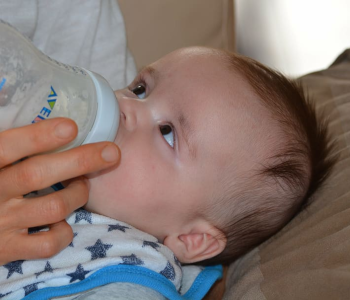
The first thing that you should know is introducing a bottle doesn’t happen in a day. Even if your baby takes a bottle the first time, they can change their minds later. It takes several days or even a few weeks to ensure your baby takes a bottle properly each time.
Here is how you should introduce a bottle.
1. Don’t Wait Forever
I know that lactation consultants’ recommendation is to wait an average of six weeks before introducing a bottle. You can introduce a bottle whenever you want, no matter what you are told.
I waited too long with my last two kids, and neither one took a bottle. When I say I waited too long, I stuck with the six to eight weeks suggestion. With my first two kids, I introduced the bottle within two to three weeks. Typically, I had my husband give the babies an ounce or so after we finished nursing here and there. It was nothing regular because I didn’t want it to bother my milk supply.
2. Have Someone Else Give The Bottle
Trust me; your baby is NOT going to accept a bottle from you. He knows that the breast is inches from him and that bottle won’t cut it. Ask your partner or family member to give a bottle to your baby and expect him to be unhappy about it.
3. Leave!
Don’t stand there and watch it! As soon as he starts to cry, your breasts will start to let down, and you’ll want to scoop him up to nurse. That won’t solve the problem, though!
Leave and stay away. As soon as your baby sees you walking back into the room to see how things are going, it’s game over. I took a walk outside or went into my garden. Try sitting out on the patio, but staying in the house and hovering is torture.
4. Keep Trying
Taking a bottle is a skill, even if you don’t realize it. So, it’s going to take time. At first, there’s a good chance that your baby will deny it entirely, but keep offering. Persistence helps, and a few scoops of patience helps as well.
5. Offer a Bottle Before Your Baby is Hungry
The best time to introduce a bottle is when your baby is calm and not starving. A starving baby will stay unsettled and keep screaming until a breast is produced to settle down.
I suggest that you nurse your baby first, but don’t fill him up. Make sure he is happy, and pass him over to your partner, who can then offer the rest of the feeding as you get up and leave the room. A smooth transition can help decrease the strangeness.
6 Tips to Try to Get Your Breastfed Baby to Take a Bottle
No one said that this would be easy. Convincing a breastfed baby that a bottle isn’t the enemy can be rather tricky. So, here are some tips that I’ve found to be helpful.
1. Try Cool and Warmed Milk
All babies are different. Some babies will take cold milk, and others will refuse everything but warmed milk. It makes sense that they prefer warm milk because it comes out of the breast at the perfect room temperature.
If you have to warm up cold milk, make sure that you use a bowl of warm water. Using a microwave is faster, but it’s easy to heat the milk too high. That can cause two problems:
- It causes hot spots that might burn your baby’s mouth.
- If you accidentally overheat the milk, it also can degrade the nutrients in your breast milk.
Neither of these is a good thing, so if your baby prefers warmed milk, teach whoever will be giving him bottles how to heat it up properly.
2. See If Your Baby Likes Being Cuddled or Rocked
Your baby is used to being cuddled and held against your chest for nursing, but they might not like that when bottle-fed. Suggest to whoever is giving the bottle that they can try rocking, cuddling, walking, or whatever might make your baby happen. Sometimes, you might have to hold the baby outward and walk around the room to distract them enough to take the bottle.
3. Try a Sippy Cup Instead
If your baby is six months old, try introducing breast milk in a sippy cup rather than a bottle. Most babies will take breast milk in a sippy cup, especially if offered with snacks or other food.
Unfortunately, it’s not a solution for little babies!
4. A Quiet Place Helps
Taking a bottle is enough stimulation for many babies, so try heading to a quiet place in your house to offer the bottle. Your partner or friend can try sitting in your baby’s nursery or turn off the TV and sit in relaxing silence.
5. Try Different Bottles
Many babies will eventually take a bottle if you find the right one. Some bottles are better for breastfed babies than others. The bottles that you want to try should have wide nipples that mean your baby has to open wider to latch, similar to how your baby latches onto the breast.
Also, look for anti-colic features. Babies intake less air when breastfeeding, so it causes less gassiness. Bottles are known for taking in air, and that might cause belly aches.
6. Use Different Nipple Flow Stages
I mentioned before that most breastfed babies never go above a stage one nipple, but that doesn’t mean it can’t happen. If your baby seems frustrated with the bottle, try moving up to step two.
On the other hand, if your baby is gagging, pulling away with milk spilling out of his mouth, or gasping, you need to go down a size.
The Best Bottles for Breastfeeding Babies
Not all bottles are ideal for breastfed babies. I highly suggest that you get two or three different types of bottles and see what your baby prefers. Sometimes, it’s just a matter of finding the right bottle for your baby.
Here are some of the best bottles for breastfeeding babies on the market.
1. Comotomo Baby Bottles
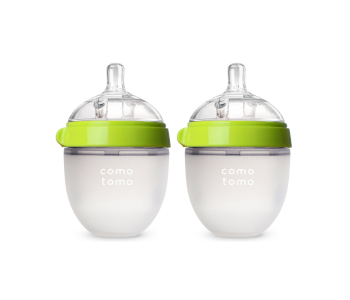
Comotomo designed their bottles to mimic breastfeeding with the goal to reduce rejection and nipple confusion. It has a wide neck design and a bottle that is made of 100% silicone. The nipple is wide with dual anti-colic vents to reduce air intake and colic problems.
2. Nanobebe Bottles
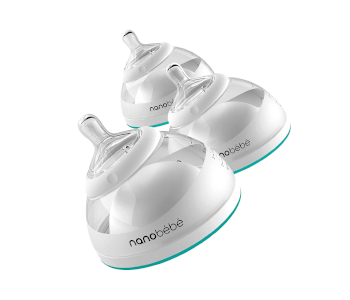
These unique bottles are shaped like a breast, making it a familiar shape for babies who need to take bottles from a caregiver. Nanobebe created their bottle to make transitioning from breast to bottle and back easy and smooth. You can hook the bottle right to the pump, pump into this bottle, and feed it to your baby.
3. NUK Simply Natural
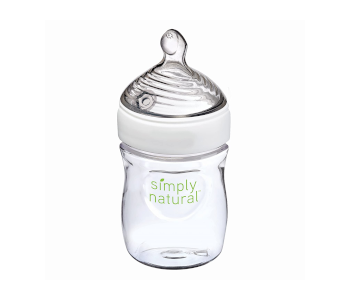
Most people recognize the brand NUK. Their Simply Natural bottle has multiple nipple holes to mimic the mother’s breast. Depending on the nipple flow, there are between three to nine holes. NUK uses a single piece anti-colic air system to reduce colic and gassiness. Babies love the super-soft silicone nipple and the wide nipple.
4. Tommee Tippee
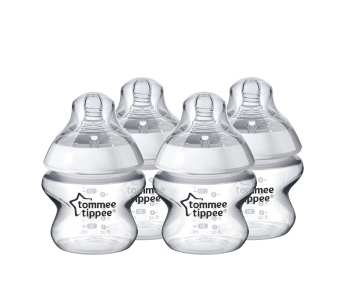
Here’s another familiar bottle brand. Tommee Tippee has breast-like shaped nipples for easy latching. They added an anti-colic nipple valve to reduce air intake and gassiness. The overall shape of the bottle makes it easy for babies to latch and drink.
Final Thoughts
Getting a breastfed baby who won’t take a bottle to do so is tricky and takes time. Drinking from a bottle is a skill, and it’s one that not all babies have the desire to learn. With persistence, patience, and an array of bottle choices, most babies will eventually learn to accept a bottle when their mother is gone.
